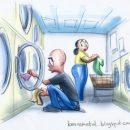I would like to talk about storytelling as behavioral therapy. As we all know, post-traumatic stress disorder – PTSD, is a significant problems for many of our service members and Veterans.
Research has shown conclusively that the best treatment for PTSD is a therapeutic strategy called Prolonged Exposure or PE. This was originally developed by Dr. Edna Foa, a psychologist at the University Of Pennsylvania School of Medicine.
From our perspective, the most interesting aspect of PE is that it involves a specialized form of storytelling.
This is how Dr. Foa describes the process, “we ask patients to close their eyes and recount the traumatic event aloud as if it is happening now, including details of what is happening, their thoughts, and their feelings. And then we record the narrative and the patient takes the recording home. When patients listen to their stories, many things happen. They change their perspective on the trauma. They might have blamed themselves for some parts of the trauma – and now they realize that there is no reason to do this. Also, their memories stop eliciting anxiety, because remembering a traumatic event is not dangerous; it is only dangerous if you feel as if it is happening now. But once they separate from the memory, they can put it into the past; they gain control over the traumatic memory and lose the re-experiencing symptoms.”
When individuals first attempt this storytelling associated with a traumatic experience, they find that they are not really stories, but are a jumble of memories, impressions and feelings which cause a great deal of distress. Intuitively, people work to avoid these memories, often with alcohol or by abusing other substances because the memories themselves are so distressing.
Unfortunately, it’s not possible to get rid of powerful memories. This is where the power of storytelling comes in.
The Idea of Behavioral Therapy.
As Dr. Foa describes, therapists help individuals to create a coherent story from the memories, impressions and feelings which are so distressing. Gradually a first-person story is developed, which is told as if it’s happening in the present moment and which has a beginning, middle and an end.
The retelling is done over and over for 30 to 45 minutes at a time. These stories elicit a lot of emotion, like many stories do, but in the end, those being treated with PE learn that even a scary story is not dangerous.
And that’s the story of prolonged exposure treatment for PTSD. Another example of how emotive storytelling is the heart and science of persuasion.










No comments yet.